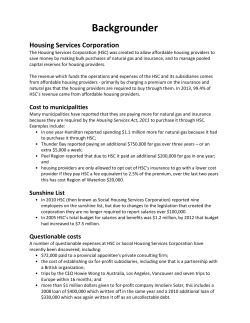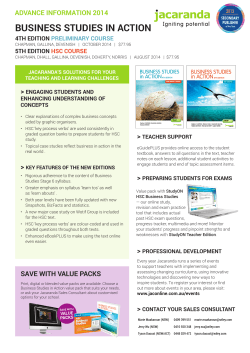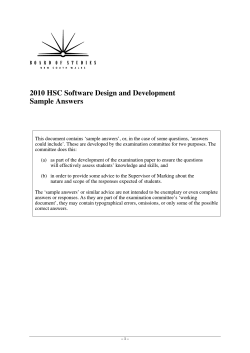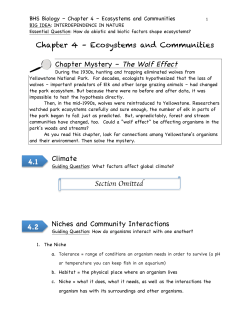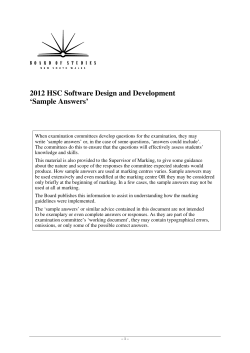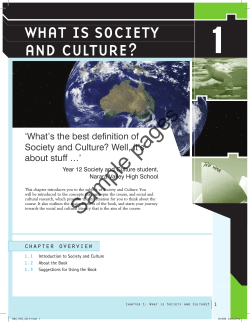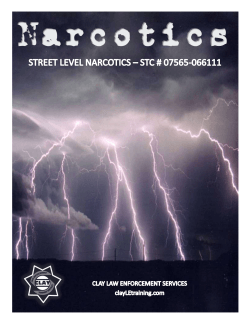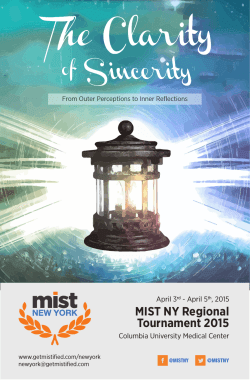
HSC GEOGRAPHY Presenter Mr. Steven Newman
HSC GEOGRAPHY Presenter Mr. Steven Newman All Saints College St Mary’s Maitland (Senior School) Important Documents • The Syllabus • HSC Examination Paper Structure 1.0 Syllabus • Key to successful HSC study is to KNOW your SYLLABUS. • HSC questions come from there. 1.1 Important Syllabus Check List • The Sacred “Dot Points” • THREE UNITS – Ecosystems at Risk – Urban Places – People and Economic Activity • Outcomes? (2007 Ecosystem question) 1.1.1 Sacred “Dot Points” • Dot Points should act as your Headings and Subheadings. Memory Joggers • HSC questions (especially extended response questions) come from the dot points. • They can act as a good summary guide. Mind Maps 1.1.2. Units: Ecosystems at Risk • TWO Parts •Ecosystems and their management •Case Studies Ecosystems and their Management • General Information on Ecosystems and how they work (function) • Important to be able to draw upon a variety of examples to support each dot point. Do not rely on TWO case studies here. Ecosystem Case Studies •Have TWO specific Case Studies. •Markers comments from 2007: Defining an area as an ecosystem is inappropriate and students studying case studies such as islands or stretches of coast that contain several ecosystems should be specific about naming and differentiating between the collection of ecosystems. •Identify and Define the type of Ecosystem you are studying e.g Coral Reefs, Coastal Sand Dunes •Identify a specific example of one: e.g Great Barrier Reef, Stockton Bight Sand Dunes •Basic Geography of your case study RELATAIVE location and ABSOLUTE location. Be able to draw a quick MUD MAP. Urban Places • Three Clear Topics – World Cities – Mega Cities – Urban Dynamics World Cities • Spatial Distribution of these places; Predominantly located in the Developed World • World Cities are best understood in terms of FLOWS. • World Cities command and control the flow of money, ideas, people and culture in a Globalised world. • This gives World Cities their distinct Characteristics: – Money: Financial Centres (Flow of money) stock exchanges, HQs for Fortune 500 companies. – In turn controlling the flow of money requires the infrastructure to be able to do this, Telecommunication nodes, Air travel hubs, transportation nodes. • Culturally, people with money want to be where other people with money are. Hence the Cultural Authority Mega Cities • A definition based purely on population Size. • Syllabus uses old United Nations Definition of 8 million or more inhabitants of a Metropolitan Area. • New Definition used by UN and World Bank etc is “10 million”. • You are safe to use both. • Spatial Pattern: A Developing World Phenomena • Characteristics: Can use challenges as Characteristics, but ensure you use the term “characteristics” in a response. • Need to draw upon a few examples not just ONE case study. Remember the Bossy “s”. Urban Dynamics • • • • This is in 3 Sections 9 urban Dynamics of Change Case Study of ONE Urban Dynamic Study of a Large City 9 Urban Dynamics • • • • • • • • • Suburbanisation Exurbanisation Counterurbanisation Decentralistaion Urban Decay Urban Renewal Urban Consolidation Urban Village Spatial Exclusion Crucial to have examples of each. Focus on ONE for your Case study of a country town or suburb ONE Case Study • Ensure you have studied ONE Urban Dynamic in ONE Suburb/Country Town. • That is, NAME the Urban dynamic and NAME the suburb/town • E.g. • Urban Dynamic: URBAN RENEWAL • Suburb/ Town: Pyrmont Large City • Needs to be a city form the developed world • Better off doing an Australian City • Sydney is an obvious choice because of proximity and most have had contact with it. • Ensure you understand the results of Urban Dynamics • SCEG – Social – Cultural – Economic – Growth People and Economic Activity • Two Parts to this unit: –Economic Activity –Economic Enterprise Distinguish between the two Economic Activity Is an Activity that is occurring Globally- Tourism, Viticulture, Aquaculture • Define your Economic Activity • Good little Acronym to remember the second dot point BEESPOT – – – – – – – Biophysical Ecological (link to global warming) Economic Sociological Political Organisational Technological Economic Enterprise • Refers to a specific example or Case Study of ONE business (enterprise) that is involved in the Economic Activity you studied. 2.0 HSC EXAM • • • • Know the Exam Structure 3 hour Exam 20 Multiple Choice (20 marks) Short Answer Questions (40 marks) • 2 Extended Response (40 marks) Combination of Skills and knowledge 2.1 Multiple Choice Skills Check list 35 minutes Interpreting/reading Skills Topographic maps Cartograms Choropleth / Thematic Maps Line, Column, Bar ,Compound and Pie Graphs Semi-logarithmic graphs tables, flow diagrams Photos Types (Oblique, Aerial, Satellite) Orientate a photo to a map. Direction Calculating Skills (ratios) Scale Vertical Exaggeration (VE=x) Gradient (1:x) Percentage change Proportional Circles Vertical Exaggeration Gradient Distance, speed, time Percentage change. Bearings Constructing Skills Cross Sections Vegetation Transects Proportional Circles Precis Maps Choropleth/ Thematic Maps 2.2 Short Answers • You have 70 minutes • Combination of Skills and Knowledge. • Get straight into question. Answer question in first sentence and then support with detailed examples. • You do not benefit by writing more than the lines provided. The skill here is to write succinctly! Extended Responses • • • • • • • 75 minutes Choice of TWO extended responses from Three questions (ONE question for each unit) Essay writing – Read Question • Determine Dot point • Bossy word • Bossy S – Paragraphs (Body of Extended Response) • ONE paragraph = ONE point • Sentence Back • Paragraph Structure – Identify a trend, pattern or major point – Explain it using geographical concepts – What are the implications – Signposts – key words that show you are answering the question. Try to use Stimulus Booklet Get past the staple in 8 page booklet Use statistics and illustrative example throughout. BOS states 600 words is sufficient, I recommend that you use time as a better gauge. All these notes can be found at http://www.mrstevennewman.com
© Copyright 2025

